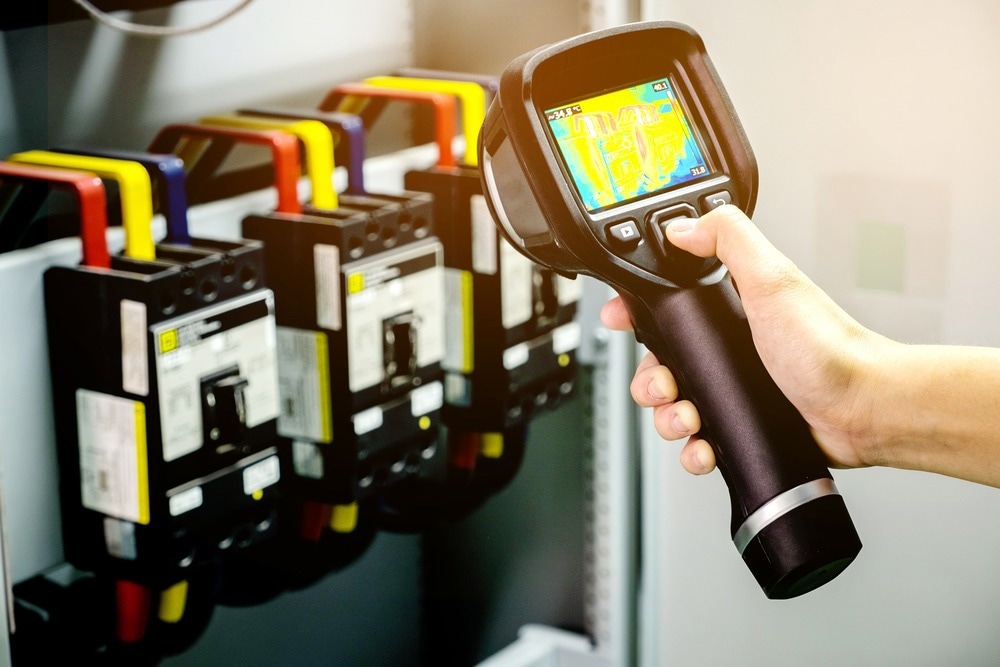 By Owais AliReviewed by Lexie CornerMar 11 2024
By Owais AliReviewed by Lexie CornerMar 11 2024Thermal imaging is vital in numerous applications—from night vision to gas sensing, machine vision, and thermography. However, existing thermal imaging systems have significant size, spectral resolution, and field of view (FOV) limitations.

Image Credit: Joyseulay/Shutterstock.com
To address these challenges, recent research has combined spinning dispersive metasurfaces with advanced computational imaging algorithms. This innovative approach was published in Optica.
Conventional Challenges and the Meta-Optics Solution
Traditional thermal imagers operating within the long-wave infrared (LWIR) spectrum often rely on bulky filter wheels or delicate interferometers to decompose incoming thermal radiation into its spectral components. While these methods have enabled spectral imaging, they come with significant trade-offs.
Filter wheels offer limited spectral resolution, while interferometers are restricted by their confined fields of view and susceptibility to environmental disturbances, making them fragile and challenging to deploy in real-world scenarios.
Recognizing these limitations, the Purdue University research team turned to the emerging field of meta-optics, which explores the manipulation of light using engineered, sub-wavelength nanostructures known as metasurfaces.
By combining large-area stacked meta-optical devices with compressive dictionary learning and sensing algorithms, they developed a compact, robust, and high-performance spectro-polarimetric imaging system called the "Spinning MetaCam."
Engineered Metasurfaces: The Key to Compact Thermal Imaging
The Spinning MetaCam's key innovation lies in its ingenious use of metasurfaces–ultrathin structured surfaces that can manipulate light in complex and customized ways.
The researchers engineered a stack of three spinning dispersive metasurfaces, each designed to exhibit specific properties crucial for optimized spectro-polarimetric imaging performance.
The first set of metasurfaces enables efficient wavelength decomposition of thermal radiation, a vital step in spectroscopic analysis. The second set enhances signal-to-noise ratio (SNR) by ensuring high transmission and low self-emission, preserving data quality. The third set enables a wide FOV for the imaging system, overcoming the limitations of traditional interferometer-based spectral imagers.
Leveraging these tailored metasurfaces, the researchers fabricated large-area meta-optical devices (25.4 mm in diameter) with high structural quality and uniformity. This scalability surpasses previous attempts at miniaturized spectrometers, making it suitable for imaging applications.
The Spinning Mechanism: Spectral and Polarimetric Decomposition
The Spinning MetaCam uniquely utilizes the rotation of metasurfaces and a broadband linear polarizer to achieve spectral and polarimetric decomposition of incident thermal radiation.
The system generates tunable transmission spectra that sample the incident radiation across polarimetric and spectral channels by spinning the metasurfaces and polarizers to different angles. This is achieved through the metasurfaces' ability to rotate different wavelengths of radiation to varying polarization orientations, effectively separating the spectral and polarimetric components of the thermal radiation.
The acquired data is then processed using advanced computational imaging algorithms, specifically compressive dictionary learning and sensing techniques. These algorithms enable accurate reconstruction of the unknown spectra from a limited number of measurements, ensuring stable and reliable spectral reconstruction even in the presence of noise and measurement errors.
Unprecedented Thermal Imaging Performance and Versatility
The researchers demonstrated the system's capability by imaging a custom "PURDUE" target with distinct micro-grating structures. The reconstructed spectra accurately captured each letter's unique spectro-polarimetric signatures, revealing complex details beyond the capacity of traditional thermal imagers.
The researchers also documented the following key achievements:
- Spectral Resolution: The system exhibited a spectral resolution of 0.6 μm full width at half maximum (FWHM) for wavelengths above 10 μm, with the ability to detect peaks as narrow as 0.1 μm FWHM, essential for detailed characterization in various imaging applications.
- Polarimetric Information: The Spinning MetaCam captured polarimetric information, including the angle of linear polarization (AoLP) and the degree of linear polarization (DOLP), forming a four-dimensional spatial-spectro-polarimetric data-tesseract that enhances its utility across diverse applications.
- Material Classification: In material classification tests, the Spinning MetaCam outperformed conventional panchromatic thermal imaging, achieving a three-fold increase in accuracy with an impressive mean average precision (mAP) of 0.834.
- Wide FOV: Unlike interferometer-based spectral imagers with limited FOV, the Spinning MetaCam offers a wide 20.5 ° FOV, extending its versatility to scenarios demanding a larger imaging area.
Research Implications and Future Prospects
The proposed spinning metasurface-based spectro-polarimetric thermal imaging technology represents a significant advancement in thermal imaging.
"Traditional autonomous navigation approaches rely heavily on RGB cameras, which struggle in challenging conditions like low light or bad weather. When integrated with heat-assisted detection and ranging technology, our spectro-polarimetric thermal camera can provide vital information in these difficult scenarios, offering clearer images than RGB or conventional thermal cameras." Xueji Wang, the study's first author and a postdoctoral researcher at Purdue ECE.
The system’s ability to reveal spectral and polarimetric signatures also opens up opportunities for non-destructive characterization and scientific exploration, particularly in understanding anisotropic thermal conduction and directional heat transfer. This could prove invaluable for materials science, environmental monitoring, and remote sensing industries, offering new insights and enabling more informed decision-making.
The researchers aim to achieve video capture while enhancing spectral resolution, transmission efficiency, and processing speed. They also plan to improve metasurface design for advanced light manipulation, extend the method to room-temperature imaging using improved materials, and incorporate techniques like anti-reflection coatings.
More from AZoOptics: How is Thermal Imaging Used in Climate Change Research?
References and Further Reading
Wang, X., Yang, Z., Bao, F., Sentz, T., Jacob, Z. (2024). Spinning metasurface stack for spectro-polarimetric thermal imaging. Optica. doi.org/10.1364/OPTICA.506813
Institution of Mechanical Engineer. (2024). Spinning 'metasurfaces' provide compact thermal imaging for navigation and medical imaging. [Online] Institution of Mechanical Engineers. Available at: https://www.imeche.org/news/news-article/spinning-metasurfaces-provide-compact-thermal-imaging-for-navigation-and-medical-imaging
Bao, F., Jape, S., Schramka, A., Wang, J., McGraw, T. E., Jacob, Z. (2024). Why thermal images are blurry. Optics Express. doi.org/10.1364/OE.506634
Ou, K., et al. (2023). Advances in Meta-Optics and Metasurfaces: Fundamentals and Applications. Nanomaterials. doi.org/10.3390/nano13071235
Nanowerk. (2024). Explaining metamaterials and metasurfaces–properties and applications. [Online] Nanowerk. Available at: https://www.nanowerk.com/what-are-metamaterials.php
Disclaimer: The views expressed here are those of the author expressed in their private capacity and do not necessarily represent the views of AZoM.com Limited T/A AZoNetwork the owner and operator of this website. This disclaimer forms part of the Terms and conditions of use of this website.